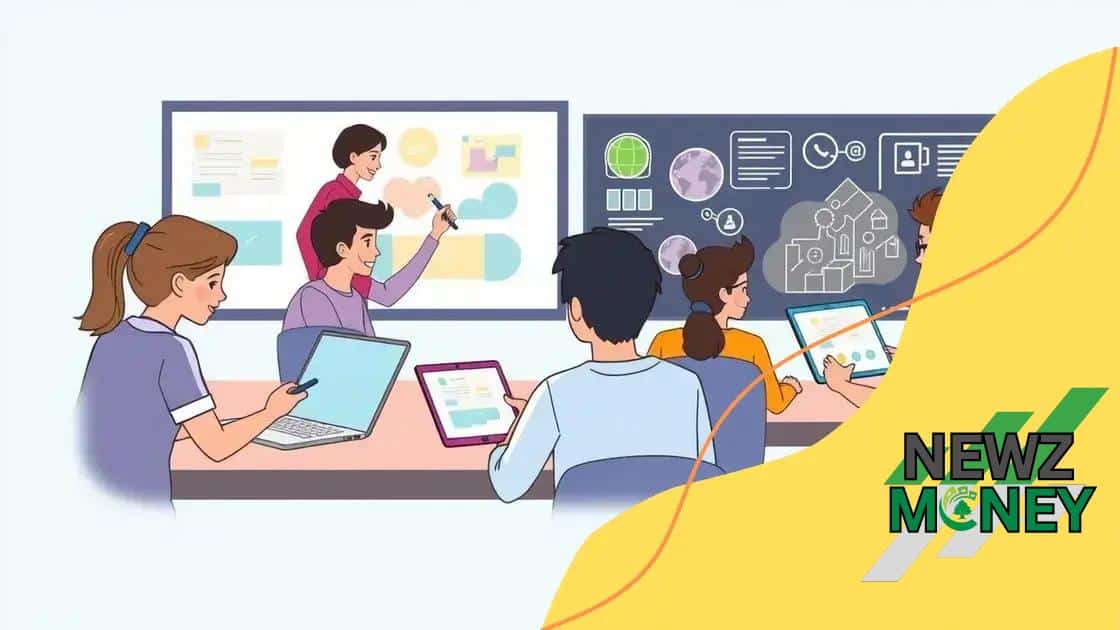The impact of virtual classrooms on student collaboration

The impact of virtual classrooms on student collaboration significantly enhances teamwork, engagement, and diverse perspectives, making online education a powerful tool for modern learning.
Have you noticed how the impact of virtual classrooms on student collaboration has reshaped our learning landscape? With remote education on the rise, the way students interact has dramatically evolved. Let’s dive into this transformation!
Understanding virtual classrooms
Understanding virtual classrooms is essential in today’s educational landscape. These digital platforms offer unique opportunities for students and teachers alike. The benefits range from accessibility to innovative teaching methods.
What are Virtual Classrooms?
A virtual classroom is an online environment where students and instructors interact. Unlike traditional classrooms, they utilize technology for lessons, discussions, and assignments. With features like video conferencing, chat rooms, and interactive whiteboards, learning becomes both engaging and effective.
Benefits of Virtual Classrooms
There are numerous advantages to using virtual classrooms for education. These benefits include:
- Accessibility: Students can join classes from anywhere in the world.
- Flexibility: Class schedules can often be adapted to meet diverse needs.
- Diverse resources: A variety of teaching materials can be utilized online.
- Enhanced engagement: Interactive tools help maintain student interest.
Virtual classrooms promote collaboration through various online tools. Platforms like Google Classroom and Zoom allow students to interact in ways that can enhance learning. They can participate in group projects and discussions without being physically present. This connectivity fosters a sense of community among learners, even in different geographical locations.
Moreover, the shift to virtual classrooms encourages the use of digital literacy skills. Students are more likely to become tech-savvy, which is crucial in today’s job market. As they navigate online learning environments, they learn how to use various applications and tools effectively.
Challenges Faced
While there are many benefits, it’s important to acknowledge some challenges. Students may struggle with time management and self-discipline in online settings. Others might experience technical issues or a lack of personal interaction with peers and teachers. Addressing these challenges can lead to more effective virtual learning experiences.
In conclusion, understanding virtual classrooms involves recognizing their potential and the hurdles that exist. They provide remarkable opportunities for learning but also require adaptation and support for students to thrive. Engaging resources and collaborative tools are key to unlocking the full potential of this educational approach.
Benefits of collaboration in virtual learning
Exploring the benefits of collaboration in virtual learning reveals how teamwork can enhance educational experiences. By working together, students gain insights and develop important skills necessary for success.
Enhanced Communication
Collaboration fosters better communication among students. When engaged in group projects or discussions, learners must articulate their thoughts clearly. This practice builds confidence in sharing ideas both online and offline.
Broader Perspectives
Working with peers from diverse backgrounds exposes students to different viewpoints. This exposure helps them think critically and appreciate various opinions. As a result, students become more open-minded and adaptable.
- Improved Problem-Solving: Teamwork encourages creative solutions to challenges.
- Social Skills Development: Students learn to work effectively with others.
- Increased Engagement: Collaboration keeps learners actively involved.
- Shared Resources: Students access a wealth of knowledge from one another.
Moreover, the tools used in virtual classrooms enhance collaborative efforts. Applications like Google Docs allow students to edit shared documents in real-time. This feature promotes teamwork, as multiple people can contribute to a project simultaneously. Students may also use platforms like Slack or Microsoft Teams to stay connected and share resources.
These collaborative experiences in virtual learning cultivate a strong sense of belonging. When students collaborate, they build friendships and support networks that can last beyond the classroom. This social aspect is crucial, especially in an online environment, where feelings of isolation can occur.
Preparation for Future Workplaces
Collaboration in virtual settings prepares students for the future. In many jobs today, teamwork is essential. By enhancing their collaborative skills, students are better equipped to contribute effectively in their careers. Employers often seek candidates who have experience working in teams, making these skills invaluable.
Through collaboration, students build the necessary skills to succeed both academically and professionally. They become more prepared to tackle real-world problems and contribute positively to their communities. The benefits of collaboration in virtual learning extend beyond grades, shaping well-rounded individuals ready to thrive in any setting.
Tools that enhance collaboration

Exploring the tools that enhance collaboration in virtual learning reveals how technology can transform the educational experience. These tools not only facilitate communication but also promote effective teamwork among students.
Communication Platforms
One of the essential types of tools for collaboration is communication platforms. Tools like Zoom and Microsoft Teams allow students to meet virtually, share ideas, and discuss projects in real-time. These platforms support video, audio, and chat features, making it easier for students to connect.
Collaborative Document Editors
Another key category includes collaborative document editors such as Google Docs and Office 365. These tools enable multiple users to work on the same document simultaneously. Students can edit, comment, and suggest changes, which encourages teamwork and enhances learning.
- Real-time editing: Students can see changes as they happen.
- Commenting features: Feedback can be left directly on documents.
- Version history: Users can track changes and revert to previous versions if needed.
- Accessibility: Documents are available from any device with internet access.
Additionally, project management tools like Trello and Asana help students organize their tasks. These platforms allow teams to assign roles, set deadlines, and track progress visually. By using these tools, students learn essential skills for managing projects in a collaborative environment.
The use of discussion forums and boards, such as Padlet or Flipgrid, fosters engagement and creativity. Students can post ideas, share resources, and respond to each other’s contributions. This not only enhances their understanding of the subject matter but also builds a sense of community among peers.
Interactive Whiteboards
Interactive whiteboards like Miro and Jamboard take collaboration to the next level. These tools allow students to brainstorm ideas visually. They can draw, add images, and create mind maps collaboratively. This visual approach helps students understand complex concepts and encourages participation from all group members.
As students engage with these tools that enhance collaboration, they develop essential 21st-century skills. They learn how to collaborate effectively, communicate clearly, and leverage technology to solve problems. These experiences prepare them for future academic and professional challenges, making the role of collaboration tools vital in today’s education.
Student perceptions of virtual classrooms
Understanding student perceptions of virtual classrooms is crucial for improving online education. These perceptions shape how students engage with the content and with each other.
Positive Aspects
Many students appreciate the flexibility that virtual classrooms offer. They can attend classes from home, overcoming geographical barriers. This convenience allows them to manage their time better and balance their studies with other commitments.
Engagement and Interaction
Some learners find virtual classrooms provide unique opportunities for interaction. Tools like chat features and breakout rooms enhance participation. Students feel more comfortable sharing ideas in a virtual format, which can lead to richer discussions.
- Increased participation: Students often engage more actively online.
- Diverse interactions: Collaboration with peers from different backgrounds.
- Comfortable environment: Learning from home can reduce anxiety.
Despite these advantages, some students express challenges. Technical issues can disrupt learning, leading to frustration. Connectivity problems might hinder their ability to participate fully. Additionally, some students miss the social aspects of in-person classes. The lack of face-to-face interaction can make them feel isolated.
Furthermore, students have mixed feelings about the effectiveness of online learning. While some enjoy the self-paced learning style, others struggle without direct guidance. This discrepancy highlights the importance of adapting teaching methods to cater to different learning preferences.
Personal Reflection
Many students report that engaging in virtual classrooms requires self-discipline. They must motivate themselves to complete assignments and participate actively. Some learners find it challenging to stay focused without the physical presence of a teacher.
The feedback on student perceptions of virtual classrooms shows a diverse range of experiences. While technology facilitates various learning opportunities, the effectiveness of virtual classrooms largely depends on how well they address the needs of their students. Educators can benefit from this feedback by continually optimizing their teaching strategies and tools.
Future trends in online education
Examining future trends in online education reveals exciting possibilities for learners and educators alike. As technology evolves, so do the methods of teaching and learning.
Personalized Learning
One key trend is the shift towards personalized learning experiences. Online platforms will increasingly use artificial intelligence to adapt content to meet individual student needs. This customization helps each learner progress at their own pace, making education more effective.
Increased Use of Virtual and Augmented Reality
Another significant trend is the integration of virtual and augmented reality (VR and AR) in learning environments. These technologies allow students to explore complex subjects in immersive ways. For example, they can visit historical sites or conduct science experiments without leaving their homes.
- Engaging Experiences: Students can experience lessons through virtual field trips.
- Enhanced Understanding: AR can help visualize complex concepts.
- Interactive Learning: VR provides hands-on experiences that are memorable.
Furthermore, the importance of social learning will continue to grow. Virtual classrooms can incorporate more collaborative tools, allowing students to work together on projects. This setup enhances communication and teamwork skills, vital for future job markets.
Flexibility in learning schedules is also expected to expand. More institutions will offer asynchronous learning options, giving students the freedom to choose when and how they study. This approach helps accommodate diverse lifestyles and commitments.
Focus on Lifelong Learning
The concept of lifelong learning will gain traction as individuals recognize the necessity of continuous education. Online platforms will provide various courses that cater to adult learners seeking to upskill or change careers. Micro-credentialing and short courses will become popular, making education more accessible to everyone.
Lastly, educational institutions will emphasize mental health and well-being in their online programs. Creating supportive online communities and resources will help students navigate the challenges of remote learning. This focus contributes to a healthier learning environment for all.
In summary, the future trends in online education point towards a more personalized, interactive, and flexible learning experience. Technology will play a significant role in shaping these changes, ensuring that education remains relevant and impactful for all learners.
In conclusion, the impact of virtual classrooms on student collaboration is significant. These online platforms enhance teamwork, increase engagement, and foster diverse perspectives. As technology continues to evolve, it’s essential for educators to adapt and embrace these changes. By leveraging innovative tools and understanding student perceptions, we can create more effective learning environments. The future of online education looks bright, with personalized learning and collaborative experiences at the forefront.
FAQ – Frequently Asked Questions about the Impact of Virtual Classrooms on Student Collaboration
How do virtual classrooms enhance student collaboration?
Virtual classrooms provide tools that facilitate communication and teamwork, allowing students to work together on projects from anywhere.
What technologies are commonly used in virtual classrooms?
Common technologies include video conferencing tools like Zoom, collaborative document editors like Google Docs, and project management platforms like Trello.
What are the benefits of using collaborative tools in online education?
Collaborative tools increase engagement, enhance problem-solving abilities, and foster a sense of community among students.
How do students perceive online learning environments?
Students have mixed perceptions; while many appreciate flexibility and accessibility, some miss the social interactions of traditional classrooms.





